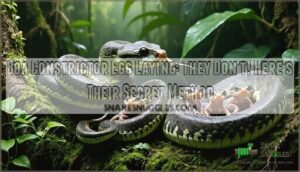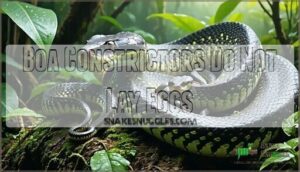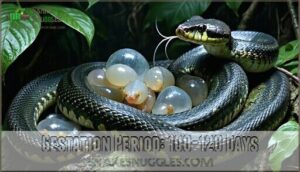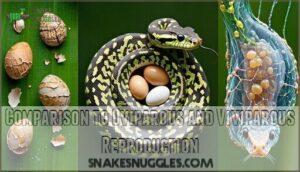This site is supported by our readers. We may earn a commission, at no cost to you, if you purchase through links.

Instead, they’re ovoviviparous, which means the eggs develop inside the mother’s body until they hatch.
You’ll see live babies emerge, typically 10-60 young after a 100-120 day gestation period.
Think of it like nature’s built-in incubator – the embryos get protection and nutrients while developing in clear membranes inside mom.
This reproductive strategy gives baby boas a head start compared to species that lay vulnerable eggs in the wild.
Understanding this unique birth process reveals fascinating insights about snake reproduction strategies.
Table Of Contents
- Key Takeaways
- Ovoviviparity: The Boa Constrictor’s Unique Reproductive Strategy
- Gestation and Litter Size
- Advantages of Ovoviviparity
- Comparison to Oviparous and Viviparous Reproduction
- Captive Breeding and Conservation
- Boa Constrictor Characteristics and Behavior
- Frequently Asked Questions (FAQs)
- How often do boa constrictors lay eggs?
- Why do boas not lay eggs?
- How to tell if a boa constrictor is pregnant?
- How many babies can a boa constrictor have at once?
- Why do boa constrictors not lay eggs?
- How many babies can a boa have?
- How long is a boa pregnant?
- How many eggs does a boa constrictor lay?
- How do boa constrictors reproduce?
- Can a boa constrictor delay pregnancy?
- Conclusion
Key Takeaways
- You won’t find boa constrictor eggs because these snakes don’t lay eggs at all – they’re ovoviviparous, meaning eggs develop inside the mother’s body until they hatch internally.
- You’ll see live babies emerge after a 100-120 day gestation period, with litters typically ranging from 10-60 fully-formed young that are immediately independent.
- You’ll discover this reproductive strategy gives baby boas major survival advantages since they’re protected from predators, temperature changes, and environmental dangers while developing inside mom’s body.
- You’ll find this method combines the best of both worlds – babies get the protection of internal development like live-bearing animals, but still develop in eggs with their own yolk supply for nutrition, and this is a result of being fully-formed.
Ovoviviparity: The Boa Constrictor’s Unique Reproductive Strategy
You might think boa constrictors lay eggs like many other snakes, but they don’t follow this typical reptile pattern.
Boa constrictors break the reptile rulebook—no eggs, just live babies born ready to conquer the world.
Instead, these impressive serpents use ovoviviparity, a unique reproductive strategy where eggs develop and hatch inside the mother’s body before she gives birth to fully formed, live young, utilizing a method that is quite distinct from the usual egg-laying approach of other reptiles, and this is due to their unique** characteristics.
Boa Constrictors Do Not Lay Eggs
You might expect boa constrictors to lay eggs, but they don’t.
These ovoviviparous snakes give birth to live young instead.
Unlike egg-laying species, Boa constrictors develop their babies internally within amniotic sacs.
This boa constrictor reproduction method gives offspring immediate neonate independence while requiring significant maternal investment and careful post-partum care for recovery.
They Give Birth to Live Young Through Ovoviviparity
Ovoviviparity sets boa constrictor reproduction apart from egg-laying snakes.
You’ll find these viviparous snakes develop embryos internally, where embryo nourishment occurs through yolk sacs.
During birth, membrane rupture releases fully-formed boa constrictor offspring.
This maternal investment guarantees neonate independence from day one.
Climatic adaptation through live birth gives boas advantages over species requiring external incubation temperatures.
Gestation and Litter Size
When you’re examining boa constrictor reproduction, you’ll find their gestation period spans 100 to 120 days, during which embryos develop safely inside the mother’s body.
You’ll discover that females typically give birth to litters ranging from 10 to 60 live young, with each newborn measuring about 20 inches long and ready for independent survival.
Gestation Period: 100-120 Days
After practicing ovoviviparity, female boa constrictors carry their developing young for 100-120 days.
This gestation period allows embryos to develop safely inside protective membranes.
Environmental influence affects timing, with warmer temperatures potentially shortening development.
Understanding boa constrictor reproduction helps explain this fascinating process.
Key gestation factors include:
- Membrane rupture occurs just before birth
- Temperature directly impacts development speed
- Mothers often refuse food during pregnancy
- Post-birth care requires maternal recovery time
Litter Size: 10-60 Live Young
When you’re observing boa constrictor reproduction, you’ll notice impressive litter variation ranging from 10-60 live young.
This live birth strategy guarantees remarkable survival rates compared to egg-laying species.
The males utilize cloacal spurs to stimulate the females during mating.
Here’s what affects boa constrictor clutch size:
- Female size: Larger mothers produce bigger litters
- Neonate independence: Babies survive immediately without parental care
- Post-birth growth: Rapid development in early years
- Genetic impact: Multiple fathers increase offspring diversity
Advantages of Ovoviviparity
You’ll find that boa constrictors’ ovoviviparous reproduction gives their babies a major survival advantage, since the developing embryos stay protected inside the mother’s body where they’re shielded from predators, temperature changes, and other environmental dangers.
This internal development also means the mother can move to find the best conditions for her young, unlike egg-laying snakes that can’t relocate their vulnerable eggs once they’re laid, providing a significant advantage in terms of survival advantage.
Provides Protection and Nourishment for Developing Embryos
When you think about boa constrictor eggs, you’ll discover nature’s brilliant protection system.
Inside the mother’s body, developing embryos receive constant Embryo Protection from predators and harsh weather. The Yolk Nourishment system delivers steady nutrients, while Maternal Care maintains perfect temperature and humidity levels.
This Enhanced Survival strategy creates a Strong Bond between mother and offspring, giving baby boas the best possible start in life.
Boa constrictors, as viviparous species, benefit from temperature-dependent sex determination.
| Protection Feature | Benefit |
|---|---|
| Internal development | Shields from external threats |
| Yolk sac nutrients | Steady food supply |
| Temperature control | Ideal growth conditions |
| Predator avoidance | Safe from dangers |
| Humidity regulation | Perfect moisture levels |
Allows for More Advanced Care and Protection of Offspring
Beyond protecting developing embryos, Enhanced Maternal Care gives boa constrictors a remarkable advantage. You’ll find mothers can actively regulate Environmental Control and provide Embryo Development Support throughout gestation.
This Predator Shielding strategy beats traditional snake egg incubation methods where boa constrictor eggs would face external threats. Yolk Sac Nourishment guarantees maximal development without reptile egg care concerns.
Parental care is a key factor in offspring survival across species.
- Mothers actively monitor and adjust body temperature for maximal development
- Predators can’t access developing young like exposed reptile eggs
- No worries about boa constrictor egg temperature fluctuations harming offspring
- Maternal positioning controls reptile egg humidity levels naturally
- Strong mother-offspring bonds form before birth, enhancing survival rates
Comparison to Oviparous and Viviparous Reproduction
You’ll notice that boa constrictors use ovoviviparity, which combines features from both oviparous and viviparous reproduction methods.
Unlike oviparous snakes that lay eggs externally for hatching, or truly viviparous animals that nourish embryos through a placenta, boas develop their young inside eggs that remain within the mother’s body until they’re ready to hatch.
Oviparous: Laying Eggs, Offspring Hatch in External Environment
Oviparous snakes lay eggs that require external incubation in carefully chosen nests. Unlike boa constrictor eggs that develop internally, these species depend on environmental factors like temperature and humidity for successful hatching.
The eggshell composition provides protection while allowing gas exchange during development. Some snakes, like the Rinkhals, lay small, leathery eggs.
| Feature | Oviparous Snakes | Boa Constrictors |
|---|---|---|
| Egg Location | External nest sites | Inside mother’s body |
| Clutch Size | Varies by species | 10-60 live young |
| Hatchling Survival | Depends on environment | Higher protection rates |
The differences between oviparous snakes and boa constrictors are notable, especially in terms of egg development and survival rates.
Ovoviviparity: Eggs Develop and Hatch Inside The Mother’s Body
When you’re exploring boa constrictor reproduction, you’ll discover their fascinating ovoviviparous process.
Internal egg development occurs within the mother’s body, where embryonic development receives maternal nourishment and embryo protection.
The eggs complete their gestation timeline internally before membrane rupture signals live birth.
| Reproductive Aspect | Ovoviviparous Process |
|---|---|
| Development Location | Inside mother’s body |
| Hatching Process | Internal development complete |
| Birth Method | Live young emerge |
Captive Breeding and Conservation
When you’re working with captive boa constrictors, you’ll find they can reproduce every two to three years under proper care conditions.
These controlled breeding programs play a vital role in conservation efforts, helping maintain genetic diversity and supporting populations of threatened subspecies in the wild.
Boa Constrictors Can Reproduce Every 2-3 Years
Unlike many reptiles that breed annually, boa constrictor reproduction follows a different pattern. Reproductive frequency in these snakes occurs every 2-3 years, allowing females to recover between breeding cycles.
Several factors influencing this cycle include:
- Breeding age requirements of 2-3 years for sexual maturity
- Health impact considerations for ideal maternal condition
- Environmental conditions affecting breeding success
- Population dynamics supporting sustainable snake reproduction patterns.
This extended cycle guarantees healthier offspring and maintains robust snake breeding populations. Successful breeding also requires specific humidity control to guarantee proper development.
Captive Breeding Programs Help Conserve Threatened and Endangered Species
Captive breeding programs serve as lifelines for threatened boa constrictors worldwide.
These innovative breeding programs offer hope and genetic salvation for vulnerable boa populations facing extinction pressures.
These initiatives tackle conservation challenges while advancing our understanding of boa constrictor breeding and reproductive needs. Many breeders require specialized boa breeding products to guarantee success.
Conservation programs focus on several key areas:
- Genetic diversity preservation through careful mate selection
- Habitat preservation efforts supporting wild populations
- Reintroduction challenges addressed through research partnerships
- Ethical considerations balancing captivity with species survival
- Program funding secured through zoo collaborations and grants
Boa Constrictor Characteristics and Behavior
You’ll find boa constrictors are impressive reptiles that can reach lengths of 6 to 10 feet and live for 20 to 30 years in their native Central and South American habitats.
These nocturnal hunters use their powerful bodies to constrict prey rather than venom, and they’re surprisingly versatile animals that can swim, climb trees, and adapt to various environments from rainforests to grasslands, making them impressive reptiles.
Large Snakes Found in Central and South America
You’ll find these Amazonian giants stretching across Central and South America’s diverse snake habitats.
Boa constrictors aren’t venomous snakes – they’re powerful constrictors reaching 13 feet and 60 pounds.
Their conservation status remains stable despite habitat pressures.
This snake diversity hotspot supports boas in rainforests and semi-deserts.
Understanding boa egg laying becomes fascinating when you realize these impressive reptiles live 20-30 years without ever laying traditional boa constrictor eggs.
These snakes exhibit viviparous reproduction, giving birth to live young in a process that is quite unique.
Use Constriction to Kill Prey
Boa constrictors don’t use bite force to kill—they’re masters of constriction mechanics.
When you watch them hunt, they wrap powerful coils around prey, applying pressure that stops breathing through prey suffocation.
This method requires no venom or crushing bones. Understanding the boa’s squeeze strength highlights their unique hunting ability.
Their hunting strategies rely on patience and precise timing, making digestive process easier since prey arrives intact.
Nocturnal and Solitary Ambush Predators
Most boa constrictors become master hunters after dark, relying on hunting strategies that showcase their sensory adaptations.
These solitary behavior experts use camouflage techniques to blend seamlessly with their surroundings.
Their prey selection focuses on warm-blooded animals they can detect through heat-sensing pits.
You’ll find them waiting motionlessly for hours, perfectly positioned for ambush attacks.
Many boas appreciate a secure hiding space to feel safe.
Can Swim and Climb Trees
You’ll find these impressive serpents aren’t confined to ground hunting.
Their arboreal adaptations and climbing strength make them versatile predators across diverse habitat ranges. Swimming technique allows navigation through water bodies while arboreal behavior provides predatory advantages in canopy environments.
- Muscular bodies grip tree trunks for vertical climbing
- Strong swimming ability crosses rivers and wetlands
- Arboreal hunting expands prey opportunities above ground
- Habitat versatility thrives in forests, grasslands, and aquatic areas
Have a Lifespan of 20-30 Years
Beyond their impressive climbing abilities, these serpents boast remarkable longevity factors that set them apart.
Boa constrictors typically live 20-30 years in captivity lifespan conditions, though wild lifespan averages slightly less due to environmental pressures.
The aging process affects their health impact gradually, with proper snake care extending their years substantially.
Understanding snake lifespan helps you provide better snake breeding environments, and their extended snake behavior patterns develop over decades, making them fascinating long-term companions for dedicated reptile enthusiasts.
Frequently Asked Questions (FAQs)
How often do boa constrictors lay eggs?
Like expecting rain in the desert, you’re looking for something that doesn’t happen.
Boa constrictors don’t lay eggs at all—they’re viviparous, giving birth to live young after carrying them internally for months.
Why do boas not lay eggs?
You won’t find boa constrictor eggs because they’re ovoviviparous – meaning eggs develop inside the mother’s body and hatch internally.
This gives babies better protection from predators and environmental threats than external eggs would provide, which is a significant advantage due to the protection it offers.
How to tell if a boa constrictor is pregnant?
You’ll notice your female boa’s midsection swelling and becoming firmer during gestation.
She’ll refuse food, become less active, and develop a more rounded appearance.
Temperature changes and behavioral shifts also indicate pregnancy.
How many babies can a boa constrictor have at once?
You’ll be amazed – a single boa constrictor can birth anywhere from 10 to 60 babies at once.
Most mothers deliver around 25 live young, though larger, older females often produce bigger litters than younger ones.
Why do boa constrictors not lay eggs?
Boa constrictors don’t lay eggs because they’re ovoviviparous, meaning eggs develop inside the mother’s body and hatch internally.
You’ll see live babies born instead, giving them better protection and survival rates than external eggs would provide, which is a result of being ovoviviparous.
How many babies can a boa have?
Surprisingly, female boas can deliver up to 60 babies in a single litter.
You’ll typically see around 25 live young born at once.
These newborns arrive fully formed and ready to hunt independently from day one.
How long is a boa pregnant?
Your boa constrictor’s pregnancy lasts 100 to 150 days, roughly 4 to 6 months. Temperature affects this timing – warmer conditions speed things up while cooler temps slow development down.
How many eggs does a boa constrictor lay?
Like a magician’s disappearing act, you’ll find boa constrictors don’t actually lay eggs at all.
They’re viviparous, giving birth to 10-60 live babies instead.
No shells, no nests—just fully-formed snakelets ready to slither.
How do boa constrictors reproduce?
You’ll discover that boa constrictors don’t lay eggs at all.
Instead, they’re viviparous, giving birth to live young after carrying developing embryos internally for 100-150 days through a process called ovoviviparity.
Can a boa constrictor delay pregnancy?
Female boa constrictors can store sperm for up to one year before ovulation occurs.
You’ll find they control timing by delaying fertilization until conditions are favorable for pregnancy and birth success.
Conclusion
Understanding boa constrictor egg laying reveals nature’s clever adaptation strategies.
You’ve discovered that these remarkable snakes don’t actually lay eggs but instead use ovoviviparity to give their offspring the best possible start in life.
This reproductive method protects developing babies inside clear membranes within the mother’s body for 100-120 days.
You’ll appreciate how this strategy gives baby boas significant advantages over species that lay vulnerable eggs in harsh environments, showcasing evolution’s ingenuity.
This unique approach highlights the remarkable snakes and their ability to thrive in various environments.
- https://animals.mom.com/boa-constrictors-give-birth-live-young-2458.html
- https://animals.sandiegozoo.org/animals/boa
- https://a-z-animals.com/animals/snake/snake-facts/snakes-that-give-live-birth/
- https://www.reddit.com/r/snakes/comments/f311pw/looks_like_my_boa_tried_to_lay_eggs_but_dont_they/
- https://animaldiversity.org/site/accounts/information/Boa_constrictor.html














